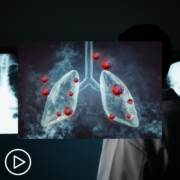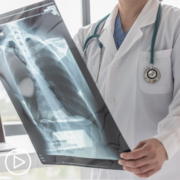How Is Non-Small Cell Lung Cancer Staged?
How Is Non-Small Cell Lung Cancer Staged? from Patient Empowerment Network on Vimeo.
Dr. David Carbone of the Ohio State University Comprehensive Cancer Center, explains how non-small cell lung cancer is staged and how staging impacts treatment.
Dr. David Carbone is a medical oncologist and professor of internal medicine at The Ohio State University. Dr. Carbone is also co-leader of the Translational Therapeutics Program at the OSUCCC – James, where serves as director of the Thoracic Oncology Center. Learn more about Dr. Carbone, here.
See More From INSIST! Lung Cancer
Related Resources:

|

|

Why Non-Small Cell Lung Cancer Patients Should Speak Up About Symptoms and Side Effects |
Transcript:
Katherine:
If we’re breaking it down to staging, let’s start with that. What are the stages?
Dr. Carbone:
Right. So, lung cancer, like many cancers, is staged I, II, III, and IV, and, of course, there’s now As, Bs, and Cs, and subcategories of those. But the basic distinction patients need to know has some utility.
So, the stage I lung cancers, in general, are small tumors that aren’t invading into anything, that haven’t spread anywhere to none of the lymph nodes, to no other structures; and they’re the tumors that we like to find. And they’re the ones whose optimal treatment is surgery, with a good cure rate.
Stage IIs, in general, are those lung cancers that are like stage I, except they involve the nearby lymph nodes in the lung that are called hilar lymph nodes, and those have also a high cure rate, but not quite as so high with surgery; and generally, are treated with surgery followed by chemotherapy, and now, immunotherapy.
Stage III is what we call locally advanced. It’s still only in the chest, but it invades some important structure or has multiple lymph nodes that are deep within the chest. And some of these are surgically resectable, but the majority of stage IIIs, I would say, are not surgically resectable, and are treated generally with chemoradiation, again followed by immunotherapy.
With the stage IV lung cancers, really, that is the lung cancer that’s spread outside the chest; typically, to bones, brain, or liver, or elsewhere in the body.
And that is typically not resectable; though again, there’s exceptions to each of these general rules, and you really need to have that multi-disciplinary evaluation of your cancers to determine the best therapy. But in general, stage IV lung cancers are not surgical candidates, not treated up-front as radiation candidates, and they’re generally treated with medical treatments that go throughout the body, and treat spots of cancer wherever they are.










